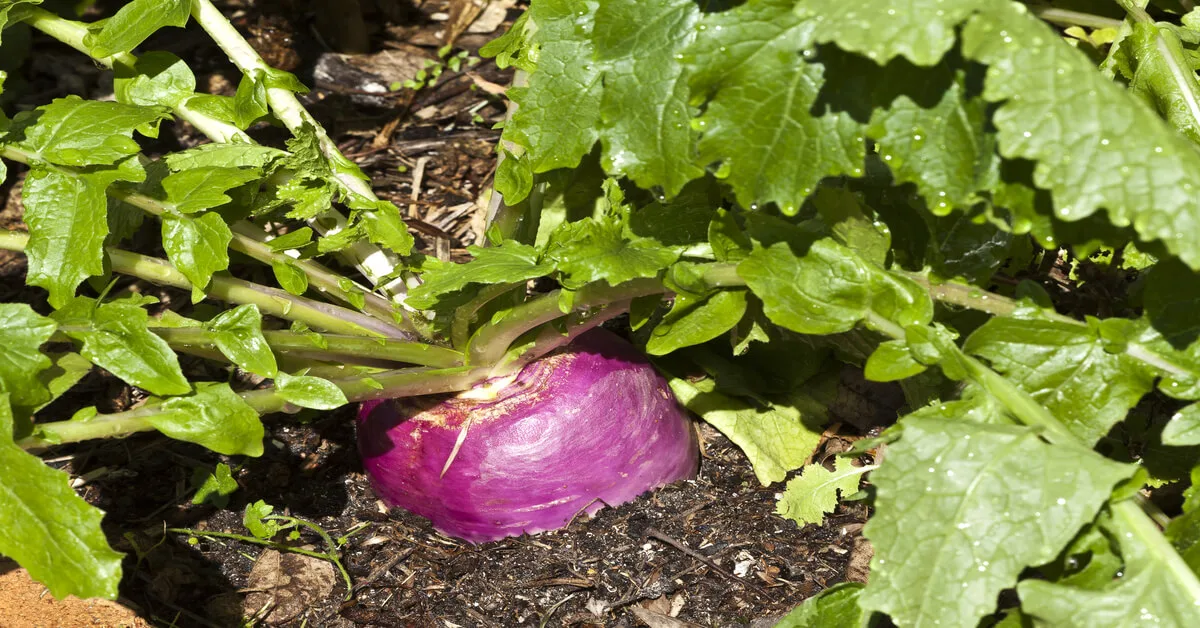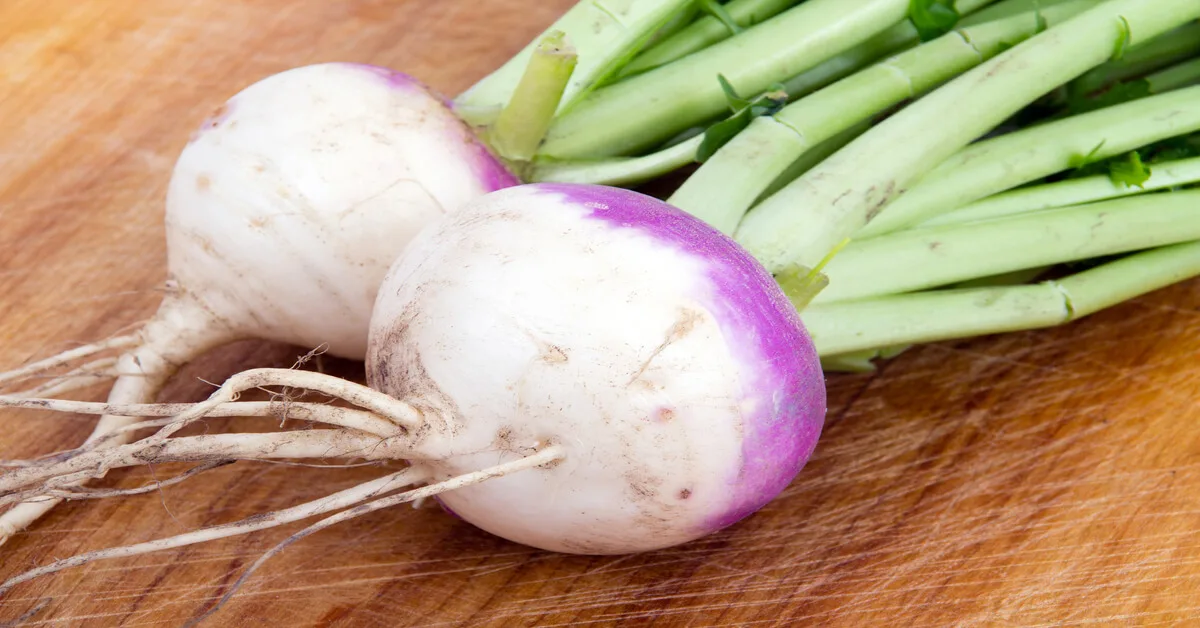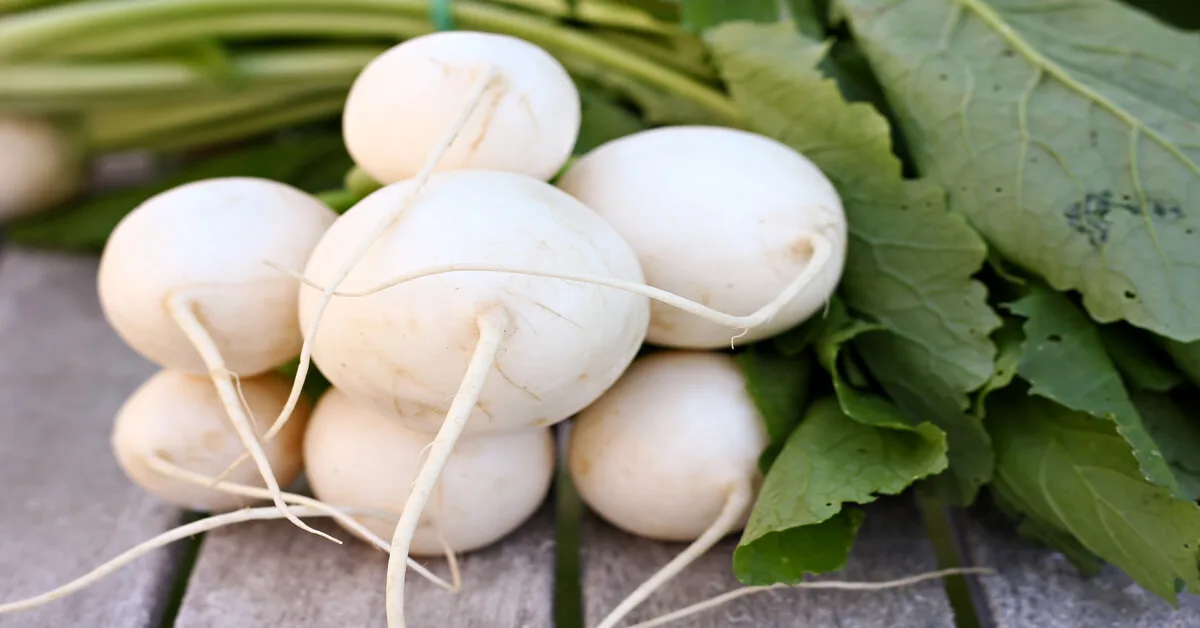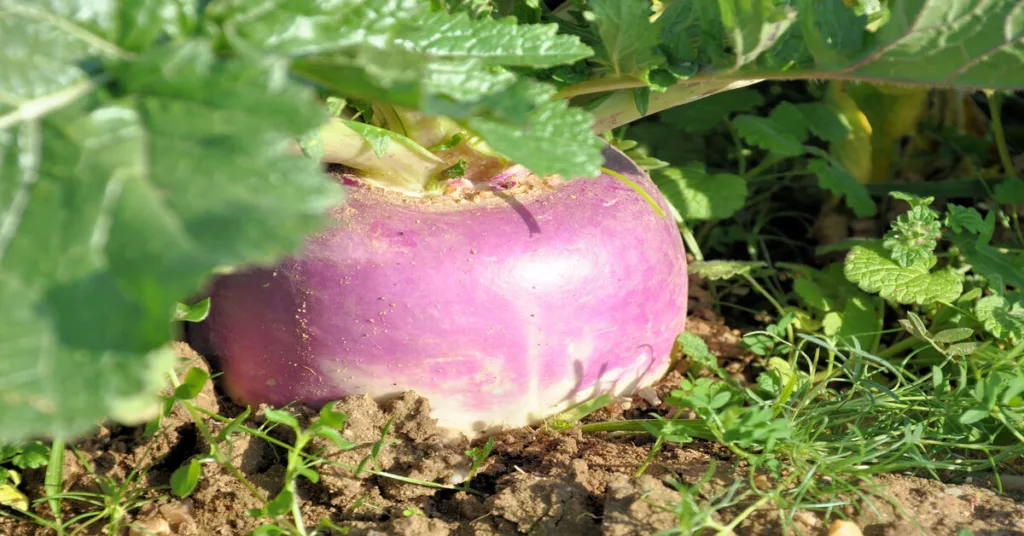Turnips (Brassica rapa) make a wonderful addition to vegetable gardens. Also, they are incredibly easy to grow. You can have a ready to harvest crop in as little as 35 days, depending on the variety you choose. But what makes this plant even more interesting than its sweet and earthy flavor is its history!
It’s believed that the vegetable in its wild growing form originated from West Asia or Europe. Later it became the vegetable that saved German civilians from starvation[1]. Also, the vegetable became a significant part of pop culture. One of the most prevalent references is Charles Dickens using the term “turnip eater.” The term was used to describe country folk in his many novels. The infamous tale of Gone with the Wind also made reference to the root veggie.
Growing turnips is more than just growing a food source; you’re also growing a small piece of history. If you want to learn about planting and growing this tasty vegetable then keep reading!
| Scientific name | Brassica rapa |
| Common name(s) | Turnip and White Turnip |
| Family | Brassicaceae (mustard family) |
| Genus | Brassica |
| Species | Rapa |
| Origin | West Asia or Europe |
| Growth habit | Biennial with edible roots and large edible leaves. |
| Leaves | Edible jagged edge medium to large green leaves with large veins. |
| Flower | Tall yellow buttercup-like with pods that hold seeds. |
| Height | Average 12″ to 14″. |
| Soil type/pH | Well-draining loose soil with high organic matter and a pH of 6.0 to 7.5 |
| Germination time | 7-14 days |
| Hardiness | 2-9 (USDA) |
Turnip Plant Care

To grow turnips from seeds successfully, you have to know about turnip plant care. This tasty biennial is one of the easiest and fastest root vegetables to grow.
From soil types to lighting requirements, GIY Plants is here to help with all of your turnip care needs!
Soil
The optimal soil type for turnips is a well-draining variety that is high in organic matter. The plant thrives when the pH of the soil is at 6.0 to 7.5. To promote healthy root development, try growing in a raised bed along with proper soil. That method also works for other root vegetables, such as onions and carrots.
Watering
If it doesn’t rain frequently in your location, you should water turnips with 2″ of water a week. Although not ideal, if you are working with a heavier and less draining soil, it is best to apply 1″ of water a week.
Lighting
The sun and lighting requirements for Brassica rapa plants in full sun. However, they can survive when given partial afternoon shade. Just be sure to choose a location where your plant can receive some sun and is not overshadowed by a structure.
Humidity & Temperature
For optimal results, it is best to grow turnips in 50°F to 60°F or 10° to 15.56° temperatures. Also, this plant prefers the humidity conditions of hardiness zones two through nine. To maintain the plants’ moisture needs, follow a consistent watering schedule.
Fertilizing
Fertilizing turnip plants is super easy. All you need to do is perform a soil test. After taking the soil test, apply phosphorus and potassium at the appropriate recommendations. It is also beneficial to apply well-rotted manure to turnip plant soil in the spring or fall. Adding a layer of well-rotted manure can eliminate the need for further fertilization.
Propagation
Like carrots, you can propagate turnips and grow them for their greens through cut tops. So when you’re in the kitchen cooking up dinner, don’t toss your turnip tops; place them cut side down into 1″ of water. After, place them in a sunny location and wait around a week for the roots to establish. Once a week has passed, you can transplant to soil and care for the plant as usual.
Diseases & Pests
Turnips can suffer from diseases that are associated with other Brassica plants[2]. Some of those include downy mildew, black leaf spot, and clubroot.
Crop rotation and fungicides can help mitigate and prevent downy mildew and black leaf spot. For the average home gardener, clubroot mitigation is not financially possible. Additionally, the pathogen that causes the disease can stay present in soil for years. Prevention is key. To aid in prevention, only plant certified seeds and avoid field-grown transplants. Also, you can add lime to the soil which helps reduce fungus sporulation.
On top of these plant diseases, there are also several pests that can affect growing turnips.
Aphids, cabbage maggots, flea beetles, root maggots, and wireworms all can infest turnips. For some of these pests, pesticides are an option, but there are also natural alternatives available for some. You can help prevent flea beetles with floating row covers. If your aphid problem is just beginning, and there are only a few leaves and shoots affected, simply prune them.
Days to maturity
How quickly your turnips mature will depend upon the variety you grow. If you want a variety with a fast turnover, plant the white lady variety. They mature in 35 days! If that’s not a fast enough growing plant for your needs, try radishes! They can mature in as little as three weeks.
Harvesting
You can harvest turnip greens once they reach maximum height or around 12″ tall. Turnip roots are ready to harvest once they reach maturity and are 2″ to 5″ in diameter. To remove the plant from the ground, use a gardening fork to loosen the soil and then remove the root.
How to Plant & Grow Turnips

Knowing how to care for turnip plants is useful information after planting. Although, if you have yet to plant turnip seeds or know how to grow them, then this section is for you! Let’s discuss when, where, and how to plant turnips. We will go over seeds for a winter turnip harvest, how to space them, what to do for growing turnip greens, and more.
- When to Plant
When you should plant turnip seeds directly depends on when you would like to harvest. If you want to harvest the veggie as soon as late spring, sow seeds two to three weeks before your final spring frost. But if an early fall harvest is what you’re reaching for, then sow seeds in the late summer season. And for a late fall harvest, sow the seeds in early September.
September will also allow you to harvest early winter turnips. That is because the plant is semi-tolerable of colder conditions.
You can also use this seed-sowing timeline when growing turnip greens specifically. You will simply sow more seeds weekly or bi-weekly.
- Where to Plant
You should plant turnips in a location with full sun exposure and temperatures of 50° to 60° or 10° to 15.56°. Hardiness zones two through nine provide the ideal conditions for growing.
Also, it’s crucial to plant in a slightly acidic soil. This root vegetable enjoys when pH levels are between 6.0 to 7.5.
- How to Plant
To ensure enough room for growth, turnip seed spacing should be 1″ to 2″ apart in rows that are 18″ to 30″ apart. Once the plants becomes a seedling, ensure to thin them to where there is 3″ to six ” between each plant. Additionally, seeds should be 0.25″ to 0.5″ deep into the soil. After, lightly cover seeds with the soil and water.
Turnip Companion Plants
To have a thriving garden that produces a bountiful harvest, it’s wise to companion plant. By companion planting, you can help protect and nourish your growing turnip seeds. Also, certain plants can help optimize your garden space when planted with turnips.
Peas and Beans
These nitrogen-promoting plants are perfect to grow with turnips. The mustard family plant will appreciate the soil boost. Although, beware, too much nitrogen can be problematic for the plant.
Garlic and Nasturtiums
These aromatic plants help keep aphids and other pests away. Therefore, your growing turnip seeds will have extra protection from pesky insects.
Mint
Planting mint in a container near your turnips can keep flea beetles away. You can also turn mint into mulch and scatter it amongst your turnip beds.
Turnip Varieties

There are so many varieties of the Brassica rapa plant that you can grow in your garden! From golden fleshed to the classic purple and white, they come in many different colors. Let us tell you about some of the most flavorful and desirable varieties that you can plant.
- Gold Ball
This tasty variety only takes 45 days to mature and is best harvested when it reaches 3″ tall for peak sweetness. As the name suggests, this variety has yellow skins with golden flesh interiors.
- White Lady
White lady turnips suit their name well and have pure white skins and fleshes. They mature quickly at only 35 days and reach 20″ in height.
- Shogoin
This 18″ to 20″ turnip also has white roots. But it does have a wide range for reaching maturity; it can take anywhere from 30 to 70 days.
- Just Right
This variety is an All-American Selection Winner that has white roots. It can reach 22″ in height and matures in 70 days.
- Purple Top White Globe
Purple top turnips can reach 22″ tall and reach maturity in 50 to 55 days. As their name suggests, this variety has purple tops to their otherwise white roots.
Turnip vs Rutabaga
The main difference between turnips and rutabagas is their coloring. Turnips are white and purple on the outside with a white flesh interior. Rutabagas have yellow and brown exteriors with orange-yellow flesh interiors. And typically, rutabagas are significantly larger. Also, rutabagas have a sweeter taste compared to turnips.
References:
[1] Rupp, R. (2021, May 3). The vegetable that terrorized Romans and helped industrialize England. National Geographic. Retrieved January 26, 2023, from https://www.nationalgeographic.com/culture/article/the-vegetable-that-terrorized-romans-and-helped-industrialize-england
[2] Turnip brassica. CT.gov. (n.d.). Retrieved January 26, 2023, from https://portal.ct.gov/CAES/Plant-Pest-Handbook/pphT/Turnip-Brassica

